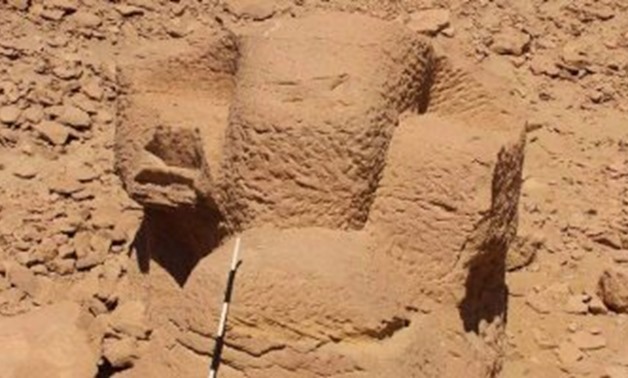
A New Kingdom sandstone workshop uncovered during excavations performed at Gebel El-Silsila archaeological site in Aswan – Egypt Today.
CAIRO – 26 February 2019: A New Kingdom sandstone workshop was uncovered during excavations at Gebel El-Silsila archaeological site in Aswan.
The discovery was executed by the Swedish-Egyptian mission led by Maria Nilsson and John Ward from Lund University. The mission discovered several sculptures as well.

Secretary-General of the Supreme Council of Antiquities, Mostafa Waziri, said that the mission also discovered a large criosphinx (ram-headed sphinx) carved in a style comparable to the criosphinxes located south of Khonsu Temple at Karnak. The statue most probably dates back to Amenhotep III era of the 18th Dynasty.
The uncovered sphinx is approximately 5 metres long, 3.5 metres high, and 1.5 metres wide.
A smaller practice piece of another criosphinx that may have been carved by an apprentice was also uncovered.
The two unearthed statues seem to have been preserved in a rough-cut and had been prepared for transportation but were most probably left at Gebel El-Silsila when the larger sculpture was broken.
Later, the Roman quarry entombed the two statues in the ground.

Furthermore, a rough-cut uraeus (coiled cobra), made to crown the head of the larger criosphinx, was discovered embedded in the walls of the workshop in addition to a blank round-top Stella.
Director-General of Aswan and Nubia Antiquities, Abdel-Moneim Saeed, said that hundreds of hieroglyphic fragments that belong to the destroyed Naos of Amenhotep III (Naos E), in addition to sculpture fragments of the associated falcon, were uncovered. Also, parts of an obelisk, including its pyramidion, were retrieved.
Saeed stressed that this is an important discovery because it proved that Gebel El-Silsila area was not only a quarry but also contained workshops for the manufacture of architectural elements used in the decoration of temples.
A total of 6,500 tourists watched the sun's alignment on the face of Ramses II status at Abu Simbel temple in Aswan for 20 minutes on Friday morning, announced the Egyptian Ministry of Antiquities in a statement.

The sun illuminates four statues seated at the top of the temple, symbolizing the facade of the temple, which resembles an edifice. Each of these statues is about 22 meters long.
This phenomenon happens twice a year on the king’s birthday and his coronation anniversary on October 22 and February 22, respectively.
The ceremony was also attended by ministers of antiquities, tourism, investment, culture and communication. Moreover, 22 African ambassadors and diplomats, along with their relatives, were in attendance.

Hussein Abdel Basir, director of the Antiquities Museum at the Bibliotheca Alexandrina, stated on Thursday that the sun illuminating the face of King Ramses II in Abu Simbel Temple is proof of how genius the ancient Egyptians were in engineering, astronomy and spirituality.
The condition of the temple was good until the Nile River levels rose, which began as a result of the construction of the High Dam and Nasser’s Lake. The Nile’s high water level could cause the temple to sink; hence it was necessary to relocate it to keep it from drowning.
The transfer of Abu Simbel Temple was one of the most difficult transfer processes throughout history. The challenge was great for architects and archaeologists alike.





Comments
Leave a Comment